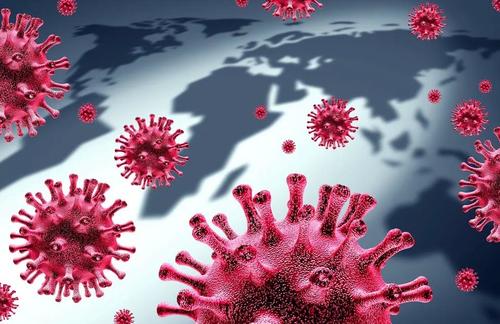To summarize this article: Covid is a nasty bug but not the end of the world.
As for the controls and especially control of information, they are far more dangerous and won't go away anytime soon, if ever.
Unfortunately, it goes one step further. Over hundreds of millions of years, virus have learned one thing alone: to survive. Which is of course what they do exceedingly well. It is said that there are already multiple variants of Covid. The UK strain is one. The South African strain another one. The vaccine may or may not be effective against these two but eventually a newer more lethal Covid virus will emerge. Just a matter of time. Then we will have a real pandemic, just when people, society and the economy will be exhausted fighting the fictive one...
Authored by Michael Snyder via The Economic Collapse blog,
A
new mutant strain of COVID-19 that has been dubbed “501.V2” has gotten
completely out of control in South Africa, and authorities are telling
us that it is an even bigger threat than the “Super COVID” that has been causing so much panic in the United Kingdom.
Of course viruses mutate all the time, and so it isn’t a surprise that
COVID-19 has been mutating. But mutations can become a major issue when
they fundamentally alter the way that a virus affects humans, and we
are being told that “501.V2” is much more transmissible than previous
versions of COVID and that even young people are catching it a lot more easily. That is potentially a huge concern, because up until now young people have not been hit very hard by the COVID pandemic.

The British press is using the word “scary” to describe this new variant, and at this point it has become the overwhelmingly dominant strain in South Africa…
The
new mutant, called 501.V2, was announced in Cape Town last Friday and
is believed to be a more extreme variant than Britain’s new Covid strain
which has plunged millions into miserable Christmas lockdowns.
Cases
in South Africa have soared from fewer than 3,000 a day at the start of
December to more than 9,500 per day, with the mutant accounting for up
to 90 percent of those new infections.
If
this same pattern happens elsewhere as this new mutant strain travels
around the globe, then “501.V2” could eventually almost entirely replace
all of the older versions of COVID.
Authorities are
optimistically telling us that the recent vaccines that have been
developed will “likely” work against this new variant, but the truth is
that they will not know until testing is done.
And if the vaccines don’t work against “501.V2”, we could be back to square one very rapidly.
For
now, countries all over the globe are banning flights from South Africa
in a desperate attempt to isolate this new version. The UK,
Germany, Switzerland, Turkey and Israel are among the nations that have
banned those flights, but so far the United States is not on that list.
So people that are potentially carrying this new version of COVID continue to enter the U.S. on a daily basis.
For the United Kingdom, this flight ban may have come too late because two cases of “501.V2” have already been identified on British soil…
Two
cases of a new, “more transmissible” COVID-19 variant linked to South
Africa have been identified in the UK, the health secretary has said.
Both
cases are contacts of people who travelled from South Africa over the
last few weeks, Matt Hancock said at a Downing Street news conference.
If
the new vaccines are effective against “501.V2”, authorities believe
that they already have the long-term answer to this new variant.
But if those vaccines don’t work, this pandemic could be entering a far more deadly new phase.
And of course we are hearing about more problems with these new vaccines on a daily basis. Thousands of adverse reactions have already been reported to the CDC, and more reports continue to pour in as more people get the shots. Here is one example from New York City…
A health care worker in New York City had a serious adverse reaction to a coronavirus vaccine, officials said on Wednesday.
New York City Health Commissioner David Chokshi said during a news conference that
the unidentified worker experienced a “significant allergic reaction”
to the vaccine. He added that the worker was treated for the reaction,
and is in stable condition and recovering.
We should
not be surprised that there are major issues with experimental mRNA
vaccines that are based on entirely new technology that were rushed into
production without proper testing.
And of course there are tens
of millions of Americans that will never take any mRNA vaccine that
literally “hijacks your cells” under any circumstances.
On
the other hand, most of the U.S. population seems to think that these
new vaccines will bring this pandemic to an end, but if they don’t work
against new mutant versions of the virus that won’t be true at all.
It is so important to take a balanced view of these things.
Unfortunately, when it comes to COVID most people fall into two camps.
The
first camp is totally freaked out because they think that COVID is
about the worst thing that could ever happen to the United States and they tend to favor extremely draconian measures to prevent the spread of the virus.
But
the truth is that the COVID pandemic pales in comparison to other great
pandemics throughout human history. The Black Plague and the Spanish
Flu Pandemic each killed at least 50 million people. As for the COVID
pandemic, the global death toll has not reached the 2 million mark even
if the official numbers are accurate. If a pandemic of this nature is
freaking people out so much, what is going to happen when a truly killer plague is unleashed in our society?
The second camp either thinks that the pandemic is greatly exaggerated or that the virus doesn’t even exist at all. Even though hordes of people are catching the virus all around us, many out there continue to deny the reality of this crisis.
I
simply do not understand that. So many people that I know around the
country have gotten the virus, and that includes quite a few big names.
For example, the following is an excerpt from an article in which Daisy
Luther shares what her experience with COVID was like…
Days
3-5: Over the next three days, chills and fever were almost constant.
My joints and muscles hurt. Getting up to go to the bathroom felt like
an expedition up a mountain. I was tired and winded. I had very little
appetite and even less of an inclination to cook food so I existed
mostly on peanut butter and crackers and leftover soup. I was absolutely
exhausted and so cold that I shivered violently when I got out from
under my bed piled high with blankets. I had super-weird dreams. My
cough worsened, my head hurt, and my throat was still mildly sore.
I
drank lots of water and electrolyte beverages. My thirst remained
unquenchable regardless of how much I drank. I took vitamins (C, D3) and
took Zinc supplements. These are my regular supplements but I doubled
that.
Days 6-9: The line to get a test at the local clinic was
long and filled with people who were coughing up a lung. There was no
way I’d be able to stand in that line for an hour, as sick as I felt.
Besides, I figured if I didn’t have Covid, I’d get it standing in the line so I opted not to be tested.
This part made me think of the worst case of the flu I ever had, except intensified by about four times. It was terrible.
I
usually let a fever run its course but by Saturday I felt so awful that
I gave in and began treating symptoms. My normal temp is in the 96s and
my temperature throughout these days stayed between 101-103. I
staggered ibuprofen and acetaminophen, and I also used a mild muscle
relaxant and my Ventilyn inhaler. The meds didn’t get rid of my fever
but reduced the chills to a tolerable level. I slept almost around the
clock, waking up for a couple of hours here and there to check on
website stuff. Fortunately, I have a wonderful team who kept things
running for us. One day blurred into the next and I considered going to
the doctor again, but couldn’t muster the energy. I felt like if I just
got a little more sleep I’d be okay.
My cough was getting far
worse and now my ribs and abdominal muscles hurt. It was a deep painful
cough that caused me to clutch my chest every single time inhaled
deeply.
So to summarize, yes the COVID pandemic is real, but it is not the end of the world.
More
people are going to get sick, and some will suffer intensely, but the
vast majority of those that get the virus will survive.
If you want to wear a mask, then wear a mask.
If you don’t want to wear a mask, then don’t wear a mask.
We should be free to make our own choices, and we should also be free to experience the consequences for those choices.
Unfortunately,
there are way too many people out there that think that they have the
right to censor and control what we say and what we do, and that trend
is likely to only get worse as our society continues to spin out of
control in the years ahead.











